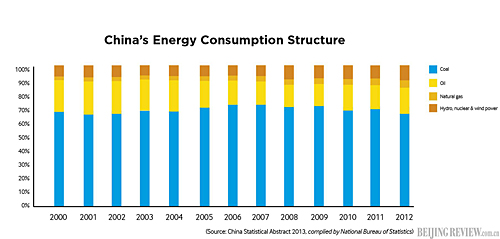|

The eastern route pipeline is not the only outlet for Russia to supply natural gas to China. Privately owned Russian gas producer Novatek finalized a deal on May 20 to supply China National Petroleum Corp. with 3 million tons of liquefied natural gas (LNG) annually for 20 years from the Yamal LNG project and Vladivostok Port. The contract for the eastern route pipeline will accelerate the implementation or even expansion of the Vladivostok project.
Another route to transmit Russian gas to China is the third west-to-east gas pipeline of China. Construction of the west and east sections of the pipeline started in October 2012, and the central section is at the planning phase. The pipeline is designed to transmit 25 billion cubic meters of natural gas from Central Asia (Turkmenistan, Uzbekistan and Kazakhstan) and 5 billion cubic meters of synthetic natural gas from Ili of China's Xinjiang. Natural gas from west Siberia will make this route more valuable and its construction will also accelerate.
At present, most of China's imported natural gas comes from Turkmenistan and Kazakhstan. Kazakhstan will soon face the political uncertainty of a power handover. Uzbekistan, which will soon expand natural gas exports to China via the third west-to-east pipeline, is facing a similar situation. Moreover, Islamic extremism, terrorism and separatism have also imposed long-running disturbances on economic and political stability in Central Asia. For these reasons, Russian gas transmission to China via the eastern route will make the country's future natural gas supplies more secure.
More benefits
The fact that Russia is expanding its pipeline gas exports to China will also weaken the control of the cartel held by Russia, Iran and Qatar over the natural gas market in East Asia. It is the "Asia premium" caused by the international natural gas cartel that makes the world's top three gas importers—China, Japan and South Korea—suffer natural gas prices four or five times the price in the United States. In March, the price of natural gas in the United States was less than $5 per million British thermal units (mmBtu), while the price in East Asia surpassed $20 per mmBtu. Russia's pipeline transmission to China proves that the cartel will not exist forever. According to a report released by the U.S.-based Petroleum Intelligence Weekly on May 20, during the week until May 10, the spot price of LNG in Northeast Asia had dropped to $13.5 per mmBtu, the lowest since October 2012. Such a decline owes, to some extent, to the expectations for the China-Russia gas deal.
In the international natural gas market with near oligopolistic competition, any progress made by an important supplier will intensify the anxiety of the other big exporters and force them to enter the same market. They will then be willing to lower the excessively high offering prices. This is a general rule in a market of this type.
Large exports of natural gas from Turkmenistan and Kazakhstan have powerfully promoted the progress of China-Russia gas negotiations. This time, the big deal between China and Russia will not only curb the prices of pipeline gas from Turkmenistan, Kazakhstan and Myanmar, but also stimulate construction of LNG projects in Australia, Canada and Mozambique and their sale promotion in the East Asian market.
The U.S. shale gas industry will also be stimulated to persuade the congress to relax its control over LNG exports so that they will not miss out on the opportunity to grab a share of the East Asian market. As mentioned, natural gas prices in the United States have declined to one fourth of those in East Asia. Therefore it is inevitable that the United States will relax its controls over gas exports. Otherwise, the U.S. natural gas industry will have to suffer losses. Once cheap natural gas from the United States enters the East Asian market on a large scale, gas prices in this region will be further cut.
Based on the above analysis, it is unfair to be overly critical of the prices set by the gas deal between China and Russia. The benchmark price of $350 per thousand cubic meters is estimated to be higher than the prices of gas imported from Turkmenistan and Kazakhstan. However, Russian gas will enter China from northeast China while gas from Central Asia will enter China through Xinjiang. Considering the cost of transmitting natural gas within China given its vast area, the actual costs of gas imported from Russia and Central Asia will be almost the same after reaching the end users. The biggest interest for China lies not in haggling over every penny, but in mutual concession with its trade partners in order to establish a mutually beneficial strategic energy alliance with Russia. This will remain a mainstay of energy security for China and even for the whole Asia-Pacific region.
The extensive construction of China-Russia natural gas pipelines will also bring huge opportunities to China's manufacturing sector. Suppliers of steel, machinery equipment, intelligent control equipment and software will benefit from the construction. Regarding the contract for the eastern route of pipelines alone, Russia is expected to invest $55 billion in the next four to six years for the construction of pipelines and supporting facilities, and China will invest $20 billion-$22 billion in construction of the related infrastructure.
The author is an op-ed contributor to Beijing Review and a researcher with the Chinese Academy of International Trade and Economic Cooperation | 